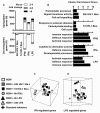HIV-1 infection of macrophages is dependent on evasion of innate immune cellular activation
- PMID: 19741482
- PMCID: PMC2873676
- DOI: 10.1097/QAD.0b013e328331a4ce
HIV-1 infection of macrophages is dependent on evasion of innate immune cellular activation
Abstract
Objective: The cellular innate immune response to HIV-1 is poorly characterized. In view of HIV-1 tropism for macrophages, which can be activated via pattern recognition receptors to trigger antimicrobial defences, we investigated innate immune responses to HIV-1 by monocyte-derived macrophages.
Design: In a model of productive HIV-1 infection, cellular innate immune responses to HIV-1 were investigated, at the level of transcription factor activation, specific gene expression and genome-wide transcriptional profiling. In addition, the viral determinants of macrophage responses and the physiological effect of innate immune cellular activation on HIV-1 replication were assessed.
Results: Productive HIV-1 infection did not activate nuclear factor-kappaB and interferon regulatory factor 3 transcription factors or interferon gene expression (IFN) and caused remarkably small changes to the host-cell transcriptome, with no evidence of inflammatory or IFN signatures. Evasion of IFN induction was not dependent on HIV-1 envelope-mediated cellular entry, inhibition by accessory proteins or reverse transcription of ssRNA that may reduce innate immune cellular activation by viral RNA. Furthermore, IFNbeta priming did not sensitize responses to HIV-1. Importantly, exogenous IFNbeta or stimulation with the RNA analogue poly I:C to simulate innate immune activation invoked HIV-1 restriction.
Conclusion: We conclude that macrophages lack functional pattern recognition receptors for this virus and that HIV-1 tropism for macrophages helps to establish a foothold in the host without triggering innate immune cellular activation, which would otherwise block viral infection effectively.
Figures





References
-
- Noursadeghi M, Katz DR, Miller RF. HIV-1 infection of mononuclear phagocytic cells: the case for bacterial innate immune deficiency in AIDS. Lancet Infect Dis. 2006;6(12):794–804. - PubMed
-
- Groot F, Welsch S, Sattentau QJ. Efficient HIV-1 transmission from macrophages to T cells across transient virological synapses. Blood. 2008;111(9):4660–4663. - PubMed
Publication types
MeSH terms
Substances
Grants and funding
LinkOut - more resources
Full Text Sources
Medical

